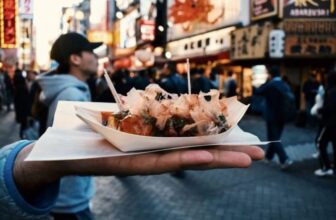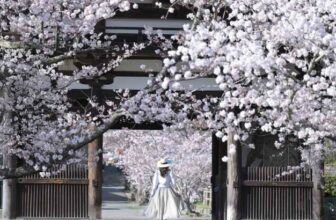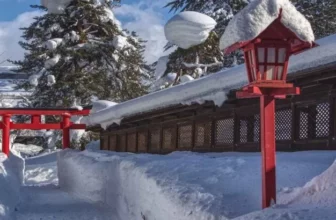Autumn in Japan brings fantastic foliage, various traditional festivals, and delicious seasonal cuisine. With everything fall has to offer, it is understandable that it is one of the best times to visit the country.
Where springtime in Japan is famous for its cherry blossoms, autumn brings breathtaking gold and crimson fall foliage. The autumn leaves are a wonderful reason to escape the city and take in the splendor of the country’s mountains and forests.
Read on to explore some of the wonderful activities and destinations to add to your itinerary.
Weather
In Japan, the fall season lasts from September until November. For the most part, the weather is moderate andenjoyable, with frequent rains that are ideal for cozy evenings next to a fireplace.
September temperatures are pleasantly warm with day temperatures ranging between 70℉ and 82℉. During October and November, temperatures slowly drop as winter in Japan approaches. Day temperatures average between 55℉ and 65℉, with evenings cooling down to between 40℉ and 50℉.
Top Activities in Autumn in Japan
Autumn in Japan offers various seasonal activities and festivals. Below are some of the top picks to add to your itinerary.
Hokkaido Shokudo, Yoyogi
The Hokkaido Shokudo has been an unmissable autumn event for foodies for over thirty years. The four-day fair celebrates local cuisines and attracts an average of three hundred thousand visitors annually. With over sixty different regional dishes to indulge in, there is sure to be something for everyone to enjoy.
In addition to the dining experiences, the festival also provides entertainment such as traditional dancing and live music performances.
Niihama Taiko Festival, Niihama City
The Niihama Taiko Festival is a cultural event that dates back over a thousand years held in celebration of a good harvest and masculinity. This vibrant festival includes a parade of gigantic floats in the shape of traditional Tokai drums. The floats weigh up to three tons and are intricately decorated with golden thread.
The festival’s biggest attraction is the Kakikurabe ritual, where around one hundred and fifty men compete to display their skills, strength, and bravery by lifting the massive float over their heads. The powerful beauty of the ritual is intensified by hundreds of men pounding their Tokai drums. It is an energetic and exciting experience supplemented by stalls selling local cuisines and handmade crafts.
Kochia Carnival, Hitachi Seaside Park
The Kochia Carnival is one of the most popular events to enjoy seasonal flora if you are looking for something different from the ordinary autumn leaves. During the fall season, nearly forty thousand red kochia plants (summer cypress) turn Mirahasi Hill in Hitachi Seaside Park into a crimson wonderland. Paved walkways are laid out around the flower fields to guide you through the most scenic spots.
After enjoying the scenery, you can visit the family-friendly Pleasure Garden in the park. It features stalls, eateries and an amusement park where visitors can enjoy over twenty-five exciting rides. At over three hundred feet above sea level, the Ferris Wheel is a fun way to enjoy the breathtaking scenery and fall foliage.
Tokyo Ramen Festa, Setagaya City
As the autumn temperatures drop from late October onwards, a steaming bowl of flavorful ramen is the ideal way to warm up. A quirky fall festival for foodies is the Tokyo Ramen Festa held at the renowned Komazawa Olympic Park built in 1964.
Dedicated to ramen noodles, this large outdoor event is held annually to support regional food culture and celebrate traditional dishes. Most regions have their own distinctive ramen cuisine, allowing you to take a culinary journey through the entire country in one location. Various authentic Japanese sweet treats and souvenirs are also available for purchase.
Tsukimi Festival, Sankeien Garden
The harvest moon is celebrated all over Japan during September with the Shinto ceremony Tsukimi, which loosely translates to moon-viewing parties. During the harvest moon, observers burn incense, make food offerings to Shinto gods, and visit shrines.
The picturesque Sankeien Garden in Yokohama is a favored location for harvest moon celebrations. This vast Japanese-style garden hosts an annual festival, where you can enjoy traditional foods, natural beauty, decorations, and shop for souvenirs.
Top Places to Visit in Autumn in Japan
Japan has an abundance of fantastic cultural and natural destinations that come to life during fall. Discover some of the best places to visit below.
Nara Park, Kansai
Established in 1880, Nara Park has a rich history and offers many amazing sights and activities. The park has lovely hiking trails, ponds, and shrines to discover. It is also home to the renowned Todai-Ji Temple, where you can make an offering to Daibutsusan, the world’s largest bronze Buddha statue.
During fall, the park’s main attraction is the population of over a thousand wild sika deer that roam freely around the park. According to folklore these deer are messengers of the gods and are considered a national treasure in Japan.
The deer are timid, social, used to humans, and willing to pose for pictures. Animal lovers can hand-feed the deer special discs of food called shikaenbei that are sold at the park.
Nachi Falls, Nachikatsuura
Nachikatsuura is a small fishing village nestled in the countryside mountains, renowned for its beautiful seaside and tuna-fishing trade. This quiet town is the doorway to the picturesque Nachi Falls. The area offers a combination of breathtaking natural landscapes and ancient culture.
During autumn, Japan’s tallest free-fall waterfall is framed with golden leaves, providing the perfect backdrop for the revered Nachi Grand Shrine. You can stroll along cobblestone pathways around the temple with a guide to learn more about the culture, history, and natural significance of the area.
Eikan-dō Temple, Kyoto
The Kyoto region is celebrated for its rich history and heritage, with many temples and shrines to explore. Eikan-dō Temple is a fantastic combination of culture and nature, making it one of the most popular destinations for viewing the fall foliage. Nighttime light-up ceremonies are held annually, with over seven hundred lights illuminating the mountainside.
The temple is also renowned for its interesting, age-old architecture. Vertical wooden corridors take you on a fascinating journey through ancient Buddhist culture. The passageways lead up to a scenic outlook point, where you can enjoy the breathtaking view of autumn leaves covering the mountainside.
Kabira Bay, Ishigaki Island
When it comes to gorgeous beaches and unusual marine life, Kabira Bay is a great tropical destination. Early autumn is a popular time to explore the natural beauty of this protected cove. Summer months are hot and humid, whereas September brings sunny days, moderate water temperatures and fewer tourists.
The clear turquoise water is home to coral reefs, tropical fish, and lush vegetation. A trip on one of the many glass-bottomed cruise ships is a great way to explore the spectacular marine life of the bay. The town also offers a variety of shops and restaurants that are known for their fresh seafood.
Oze National Park, Kantō
Oze National Park is one of the most celebrated destinations for experiencing autumn in all its splendor. The most popular area in the park is Ozegahara Marshland, Japan’s largest highland marsh. Located more than four and a half thousand feet above sea level, the marshland has lush vegetation and hundreds of small ponds to lounge in.
Nature lovers and hikers will love the variety of walking trails surrounded by crimson and golden leaves. Guided hikes and mountain-climbing activities are also offered for adventurous visitors.
FAQs
1. What to Wear in Japan in Autumn?
The best way to pack for the fall season in Japan is to bring clothes for the sunny days, and warmer clothes you can layer on as needed. Remember that rainfall is common during autumn, so pack an umbrella and raincoat.
2. What does Autumn Symbolise in Japanese Culture?
The fall season in Japan symbolises renewal, new ventures, and artistic inspiration. Autumn is known as the “season of art”, as the golden foliage and spectacular scenery have inspired Japanese poets and artists for centuries.
3. Is the Autumn Season in Japan Expensive?
Travelling to Japan in autumn is slightly more expensive than in other seasons due to the allure of the spectacular fall scenery. Keep in mind that the majority of the country runs on cash and not all foreign credit cards are accepted and you may struggle to find an ATM.
4. How do I Stay Connected in Japan?
The majority of Japan’s larger cities have Wi-Fi readily available. If you are planning to travel off the beaten path, you might struggle to find a steady connection. If you need to stay connected for the duration of your trip, SIM cards, cell phones, and portable Wi-fi routers can be rented at airports at reasonable prices.
5. What is the Best Way to Travel Between Cities in Japan?
Using the modern Japan Railway is the easiest and fastest way to travel between destinations. Purchasing a Japan Rail Pass is a smart move since it enables quick and simple travel and is less expensive than paying for each train trip individually. Before travelling, make sure to read up on proper railway etiquette in Japan.





